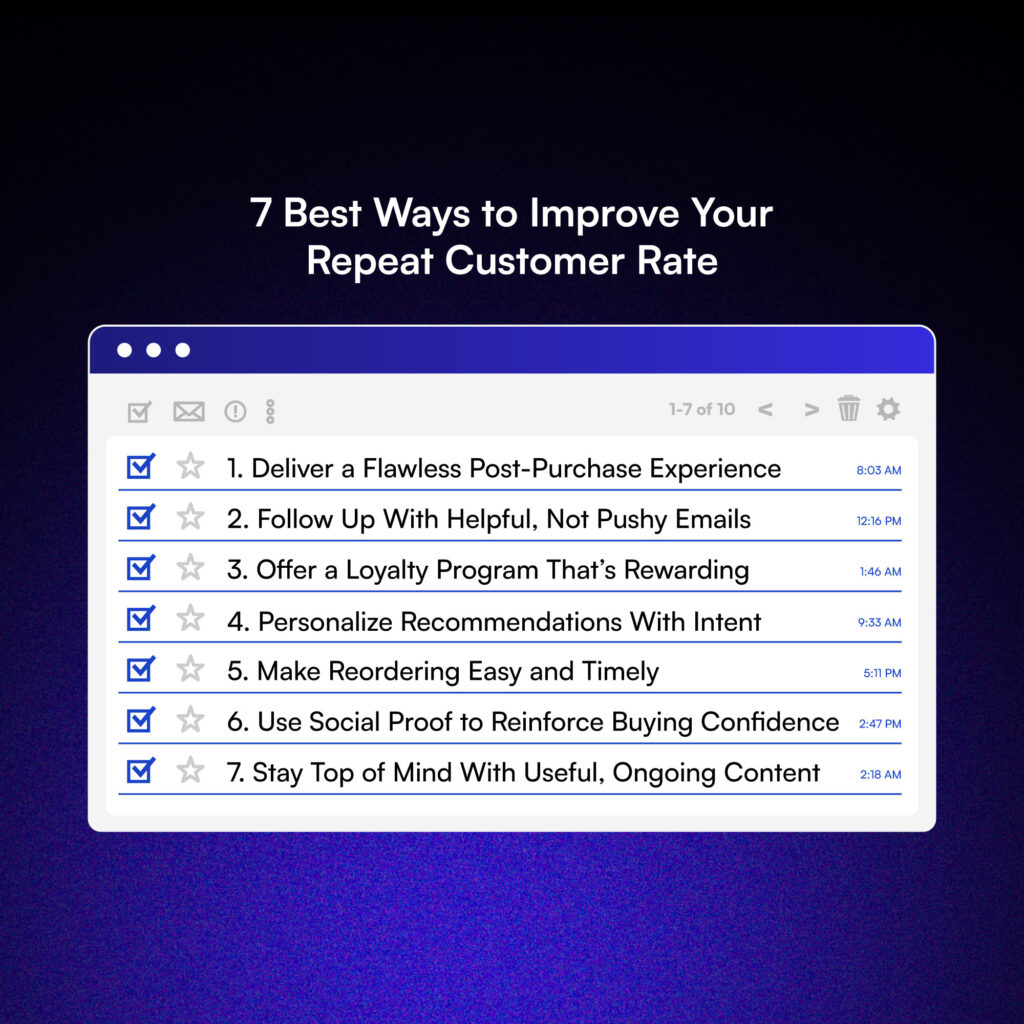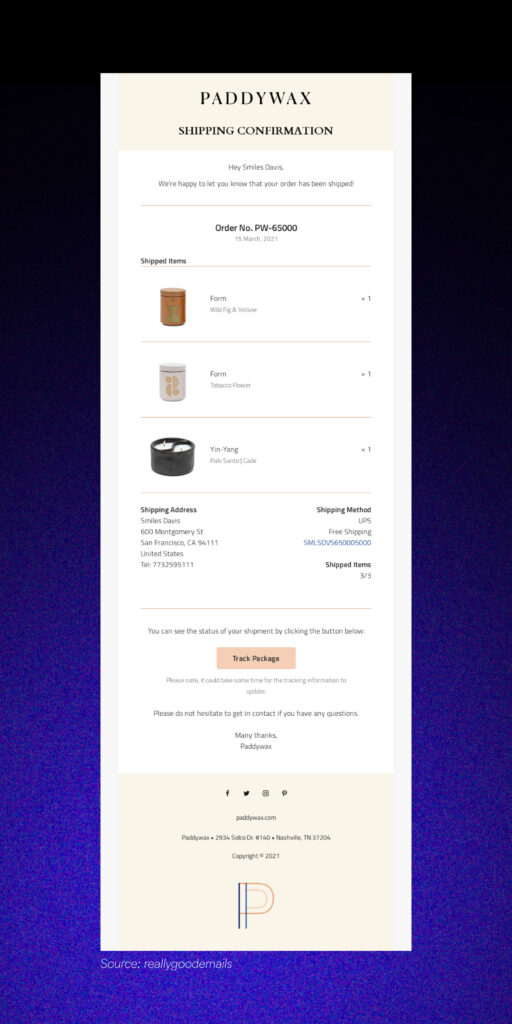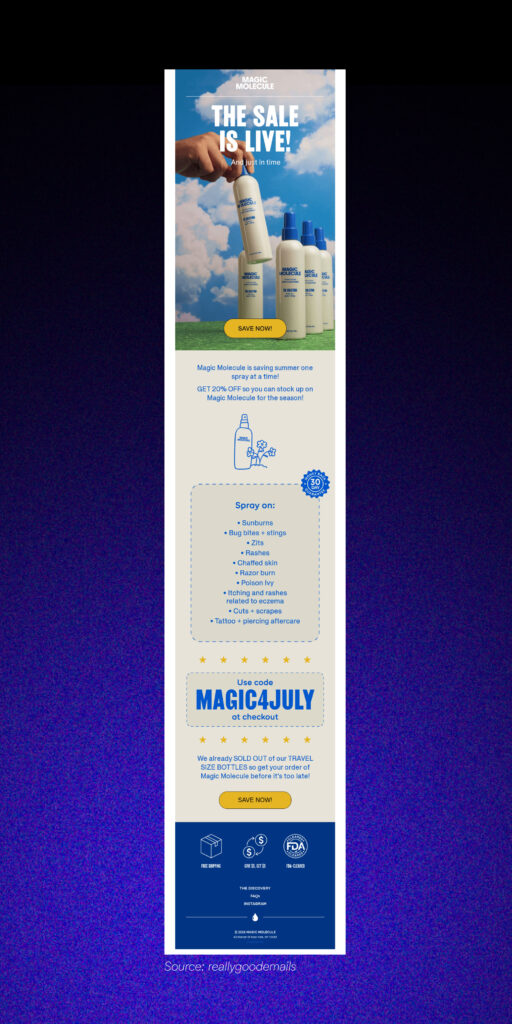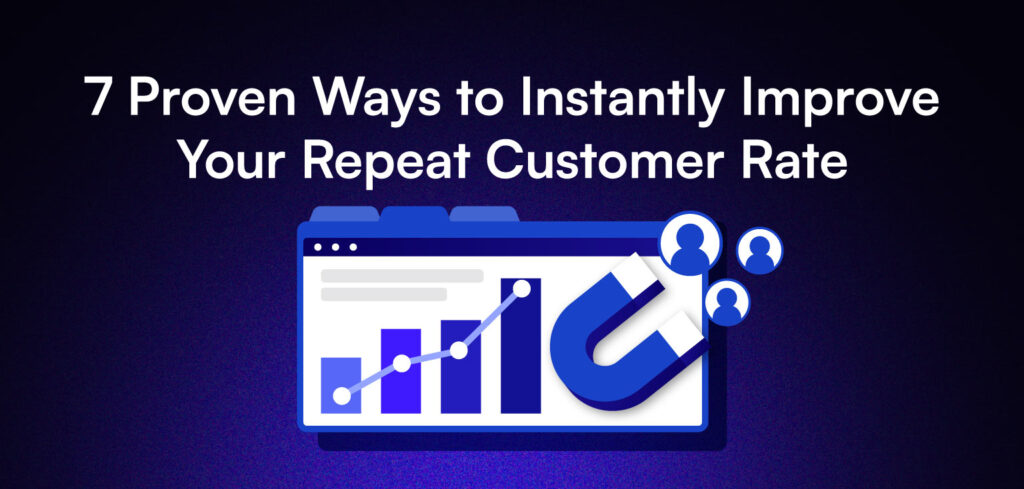Getting the first sale is tough, but getting the second one?
That’s where the magic (and profit) happens.
That’s where the magic (and profit) happens.
If you’re not actively working to increase your repeat customer rate, you’re losing serious money.
But here’s the good news: keeping customers returning doesn’t have to mean flashy loyalty programs or endless discounts. Often, it’s about the small, thoughtful touches that make your brand memorable and your customer experience smooth.
In this guide, we’ll walk you through proven ways to improve your repeat customer rate without resorting to gimmicks. Each tactic is practical, easy to implement, and designed for brands that want long-term growth.
7 Best Ways to Improve Your Repeat Customer Rate

From the moment someone hits “buy,” every interaction shapes whether they’ll come back again or not.
So, if you want more loyal customers and high repeat customer rate, here are the 7 best ways to make that happen.
1. Deliver a Flawless Post-Purchase Experience

The experience after someone buys from you is just as important as the one before. This is where you either build trust or break it.
- Send a clear order confirmation immediately: This email isn’t just a receipt. It reassures the customer that their order went through and gives them something to refer back to. Include what they ordered, when to expect it, and how to reach support if needed. This sets the tone for transparency and professionalism.
- Keep customers informed with shipping updates: Silence after checkout creates anxiety. Let your customers know when their order ships, provide tracking info, and update them on delays if they happen. This shows that you’re reliable, and it keeps excitement high while they wait. Take a cue from Paddywax’s shipping email. It’s not just functional; it’s on-brand, clean, and even includes a warm message to maintain the emotional momentum of the purchase. That blend of clarity and friendliness makes all the difference in building brand trust.
- Include onboarding or usage content: Don’t assume they’ll figure it out on their own. Whether it’s styling tips for apparel or usage guides for supplements, helpful content ensures they actually use and enjoy your product. That’s how you reduce returns and boost repeat customer rate.
Pro tip: Schedule your content emails to follow the shipment notification by a few days. That’s when they’re most likely to have the product in hand and be eager to engage.
2. Follow Up With Helpful, Not Pushy Emails
A post-purchase email shouldn’t always mean “here’s another thing to buy.” It should make the customer feel supported.
- Start with a thank you and a next step: A thank-you email shows appreciation, but go further, suggest what they might want to do next. That might be reading a guide, watching a video, or joining your community. Make the relationship feel two-sided.
- Send content that adds value based on what they bought: If someone buys skincare, share a skincare routine. If they bought cookware, send recipes. The more tailored your content, the more it feels like you’re looking out for them, not just trying to sell again.
- Include a soft upsell, but only when it makes sense: If there’s a clear next product they’ll benefit from, introduce it gently. For example, if someone buys a camera, it’s natural to suggest a case or lens cleaning kit later. Prioritize usefulness over sales pressure.
3. Offer a Loyalty Program That’s Rewarding
Loyalty programs only work if people feel like they’re getting real value, so skip the fluff and focus on meaningful perks.
- Make rewards easy to understand and earn: Avoid overly complex point systems. Tell customers exactly how they earn rewards and what those rewards are worth. Clear, simple rules increase participation and usage.
- Give early access, exclusive perks, or “just because” treats: Real loyalty comes from an emotional connection. Let VIPs shop new products early, get surprise discounts, or receive birthday gifts. Target’s Target Circle is a great example, it feels curated and worth joining.
- Promote it naturally in post-purchase and nurture flows: Don’t just announce your loyalty program once and forget about it. Include reminders in thank-you emails, newsletters, or reorder nudges. Reinforce the value by showing how close they are to the next reward tier.
4. Personalize Recommendations With Intent
Personalization isn’t just putting someone’s name in the subject line, it’s about relevance. And when done well, it can massively increase repeat purchases.
- Base suggestions on what they’ve already bought: Use past purchases to recommend items that complement or naturally follow. Bought a yoga mat? Suggest resistance bands or a foam roller next. The key is to make the customer feel like you “get” them, not just that you’re trying to sell more.
- Time your recommendations around usage habits: If a customer just bought coffee beans, wait a week or two before suggesting a refill or a related product like a new grinder. Klaviyo and other platforms let you set timing rules so these nudges hit when they’re most likely to convert.
- Make recommendations feel curated, not generic: Instead of “You may also like,” use phrasing that feels more tailored. Try “Picked just for you” or “Based on what you loved last time.” Pair it with personalized visuals to boost clicks and conversions.
5. Make Reordering Easy and Timely

If someone loved your product, the only thing standing between you and a repeat sale is convenience. Don’t make them work for it.
- Send replenishment reminders before they run out: For consumables, think skincare, supplements, and pet food; timing is everything. If you know the average product lifespan, set an automated email to go out a few days before they’ll likely need more. This keeps them stocked and loyal.
- Include one-click reordering options: Nobody wants to dig through their inbox or log in to reorder. Include a single-click button that pre-fills their last purchase into a cart. The less friction, the more likely they are to complete the purchase.
- Offer incentives for setting up auto-renewals: Consider offering a small discount or bonus points for choosing a subscription or auto-ship option. Many top DTC brands (like Billie or Native) do this to lock in future purchases while offering value up front.
6. Use Social Proof to Reinforce Buying Confidence
Even repeat customers can hesitate, especially when trying something new. Social proof helps tip the scale.
- Highlight reviews and testimonials in follow-up emails: Show what others love about the product they just bought, or about related products. It reassures the customer they’re not the only one making that choice and adds a sense of community around your brand.
- Include star ratings next to product recommendations: When cross-selling or upselling, adding a visible rating (like “4.8 stars from 500+ reviews”) builds trust quickly. Customers are far more likely to try something that others have already vouched for.
- Feature user-generated content or case studies: Showcase how real people use your products. Think customer photos, stories, or before-and-after results. This doesn’t just build trust, it also inspires new use cases that drive more purchases.
7. Stay Top of Mind With Useful, Ongoing Content
You don’t need a sale to show up in someone’s inbox. Some of the best-performing emails don’t sell; they help.
- Share tips, tutorials, or relevant updates regularly: Educational content builds trust and keeps your brand in the conversation between purchases. For example, if you sell skincare, send seasonal skin tips. If you sell cookware, share quick recipes or cleaning hacks.
- Match content to the customer’s stage or purchase: If they’re new, send beginner-friendly content. If they’re repeat buyers, go deeper, offer pro tips, advanced features, or community stories. Content becomes more impactful when it feels made just for them.
- Use a consistent format to build familiarity: Whether it’s a monthly “insider scoop,” a weekly product tip, or a seasonal round-up, consistent content builds anticipation. Customers come to expect and even look forward to hearing from you, which keeps churn low and engagement high.
Pro tip: Include CTAs like “Save this tip” or “Reply and tell us your favorite” to create two-way engagement. Email should feel like a relationship, not a broadcast.
Turn One-Time Buyers Into Lifelong Fans
You worked hard to get the first sale. The second (and third) won’t come from luck, they’ll come from strategy.
Every email, every nudge, every bit of value you offer post-purchase helps shape how your customer sees your brand. If they feel understood, appreciated, and supported, they’ll keep coming back, not just because they need your product, but because they like buying it from you.
Pick one of the seven repeat customer rate tactics and start small. Maybe it’s refining your post-purchase flow. Maybe it’s adding a “You might also like” block. The sooner you begin improving that experience, the sooner your one-time buyers become loyal ones.


